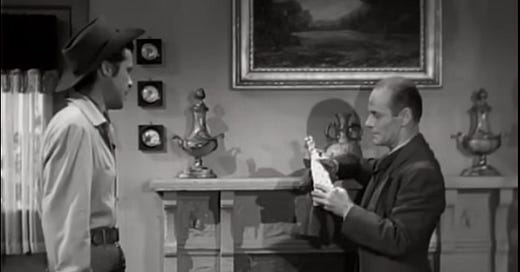ECP 320: The Lone Ranger - "The Squire" (November 9, 1950)
The Lone Ranger confronts his greatest foe: a middle-aged man
What I watched: The ninth episode of the second season of The Lone Ranger, a kid-friendly Western created by George Trendle and starring Clayton Moore as the titular hero and Jay Silverheels as Tonto. "The Squire" was written by David Lang, directed by George B. Seitz Jr., and featured guest stars Margaret Kerry, Hugh Prosser and George Lynn. "The Squire" aired on Thursday, November 9, 1950 on ABC at 7:30 pm., and is available on YouTube.
Starring: In addition to the usual crew, we have the third of four scripts written for The Lone Ranger by David Lang. Lang’s career is perhaps symbolic of the changing tides of Hollywood. In the 40s he predominantly worked on B-movies with sordid titles like Queen of Burlesque or Web of Danger, but in the 50s he gradually transitioned to working on squeaky-clean TV Westerns. He would only have one more script for The Lone Ranger, in three episodes time, but we’ll see his work pop up throughout the decade.
What happened: We open with Tonto and the Ranger mid-adventure, as they’re chasing a group of bank robbers. They’ve lost the trail, while the quartet of robbers are upset that they’ve show their faces. This week’s female character is also having a crisis, as her exhausted dad collapses. Tonto hears her cries for help, but the Ranger assures him that a girl couldn’t be involved in a bank robbery. They go to help out the father and daughter.
The father is Amos Carter (Prosser) the man who identified one of the gang members, and his daughter is Jane (Kerry). The outlaws are after them. The Ranger puts on the witness’s vest to get the criminals to chase him instead. He leads them away before returning. Jane tells them that there’s no sheriff in the town since the outlaws killed him, but a guy named Squire Turnbull (Lynn) enforces order. He sounds trustworthy.
We immediately learn that the outlaws are working for Turnbull, a rather laconic balding man. He’s worried about Carter getting to the neighbouring county and repeating his story. The Ranger stops by the windowsill just in time to overhear Squire ordering them to kill Carter. The Ranger quietly punches out a man.
Meanwhile, Tonto sets up a dummy by the window to draw the outlaws’ fire. The goons find the trap, and argue over who should take the shot before hitting the dummy. When they don’t immediately leave, Tonto assumes they’ve seen through the ruse and fires back. The Ranger arrives just in time to defeat the men. Jane rides off to the Squire’s house for help, just before the Ranger can tell them that the Squire is a bad dude.
Jane is naively telling the whole story to the Squire, who assures her that the Lone Ranger is not to be trusted. We agree on that. When the man with the signature scar comes in, Jane realizes what’s really going on. The bad guys settle on using Jane as bait to lure the good guys into a trap. But before he can do anything, the Ranger pops in and shoots the gun out of the Squire’s hand. Must be running short on time.
The scar-faced man shows the Ranger where the money was, just to get back at the Squire for trying to throw him under the bus. The Squire tries to escape again, but the Ranger pretty quickly punches him out and gives the other guy a judo throw. Jane finally recognizes from the legends she’s heard that he’s the Lone Ranger.
What I thought: This week’s episode of The Lone Ranger has a slightly different structure than we’ve come to expect, with the story starting mid-action scene. Thankfully, this spares us (or at least delays) a lot of the tedious set-up that occurs in many episodes. We already know that the Ranger and Tonto get involved in criminal situations, and we know they chase bad guys, so why not skip the preamble?
Still, the small amount of formal experimentation is the only thing to distinguish this forgettable episode. The bad guy, the eponymous Squire, is another attempt at a high-society, faintly effeminate villain, but he’s not as fun as, say, the evil watchmaker. Maybe if they went all the way with the medieval theme, and had him fighting the Ranger with a sword and shield. But no, he’s just a balding guy, and if I wanted to see an underwhelming balding guy, I would look in the mirror.
I recently finished reading Erik Barnouw’s The Golden Web as background research, and one of the things he mentions was controversy over violence on television, which began gathering steam shortly after this period. The violence in The Lone Ranger, and most shows of its ilk, is so cartoonish as to be symbolic: the Ranger throws a punch that misses by a mile, and there’s an exaggerated sound effect as the villain reels backwards; the enemy goons unload their guns without ever so much as grazing our heroes.
But this is also an episode that begins with violence, ends with violence, and has violence in the middle, no matter how abstracted. After decades of action movies and TV, to say nothing of video games, it’s easy to not even realize how much combat is a plot mechanism, but I can certainly understand why a parent would be disturbed by even such an innocent-seeming show such as this.
Coming up next: Burns and Allen are back, dealing with the hilarious world of tax assessment.





